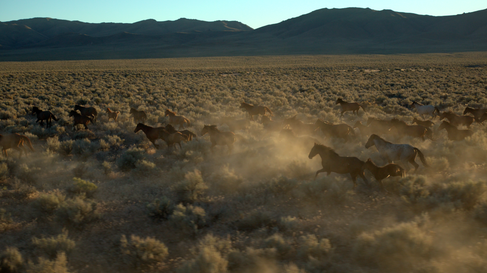- AIRWOLF

- Nov 6
- 5 min read
Updated: Nov 10

Since June, the Boot Barn HAWX Workwear x AIRWOLF collaboration has been in motion, an ambitious production blending grit, craftsmanship, and aerial precision. The campaign, titled “Driven to Succeed,” took us to the rugged landscape of Swing Arm City, Utah, where teamwork and American ingenuity collided against unpredictable desert elements.
This wasn’t just a film shoot. It was a celebration of hard work, raw skill, and perseverance through the unexpected.
Partnering with Lost Angels Career Center
At the heart of this story was a partnership between Boot Barn HAWX Workwear and the Lost Angels Career Center, a Los Angeles-based nonprofit that empowers students through hands-on training in automotive and fabrication trades.
Together, they built a custom truck from the ground up, every weld, panel, and paint detail completed by students. To bring that build to life, The All-American Sender, known for his off-road expertise and massive jumps, joined forces with the team. His knowledge of Swing Arm City and ability to read terrain shaped the film’s dynamic energy and authenticity.

A Week in the Utah Desert

For a full week, our crew camped deep in the Utah badlands, embracing the cold mornings, relentless dust, and even bouts of wind and rain. Instead of fighting the weather, we used it to our advantage. The gusts kicked up powerful dust plumes, and the light rain darkened the desert clay, giving our frames an atmospheric tone that perfectly matched the rugged spirit of HAWX Workwear.
The changing weather brought challenges but also character. Each flight, each frame, became a reflection of adaptability, something that runs deep in both filmmaking and the working-class story we were telling.

And while we battled the elements, we were fortunate to have celebrity chef Jeremiah Doughty on-site as our private chef. Known for his work as From Field to Plate, Jeremiah kept the team fueled with open-fire meals prepared daily in camp. From sunrise coffee to dinners under the stars, he turned the desert into a full-scale outdoor kitchen, reminding us that even in the toughest conditions, great food and great teamwork go hand in hand.
Bringing the HAWX to Life

In keeping with the spirit of the brand, Boot Barn HAWX Workwear brought in Hawk on Hand, a professional bird handling company that brought a hawk wrangler and a live hawk to set. The bird became the campaign’s on-site mascot, soaring over the desert and circling the crew between takes. Even landing on our Dp's head.
Working with a live animal in the middle of the Utah badlands came with its own challenges. The hawk’s behavior depended heavily on the weather, and the harsh, windy desert conditions made every flight a careful calculation. Coordinating drone paths, camera angles, and the hawk’s movements required extra patience and communication across departments.
Despite the unpredictability, the results were breathtaking. Watching the hawk glide through the shifting light and dust added an unforgettable layer of symbolism to the film—representing strength, precision, and focus. Its presence became the living embodiment of the HAWX name itself, tying the campaign’s visuals and message together in a powerful way.
Precision from the Sky
Capturing the essence of this campaign from above required both technical precision and creativity. Our AIRWOLF team deployed two aerial platforms, each purpose-built for the extremes:
DJI Inspire 3 delivered stabilized cinematic visuals and long, sweeping tracking shots in 8K full-frame RAW. The Inspire 3’s combination of a powerful sensor and DL mount lens options provided unmatched flexibility and image quality. Even in 2025, it remains the benchmark for professional aerial cinematography.

FPV Cinelifter was our 8" X8 Cinelifter carrying the Freefly Systems Ember high-speed camera, capturing dynamic off-road action at 500 frames per second.
Early in pre-production, our team recommended flying the Freefly Ember, knowing its robust design could handle vibration and dust. What we didn’t anticipate was how well it would perform at blue hour. Shooting slow motion at high frame rates typically demands more light, but the Ember exceeded expectations, producing some of the most moody, cinematic looks of the entire project.
One of the most unforgettable moments came when we flew our FPV Cinelifter straight through the dirt trails of the trucks doing donuts.The drone plunged into the swirling chaos of dust, capturing every grain in 500fps detail as the sun cut through the haze. Those shots became signature visuals of the “Driven to Succeed” campaign, chaotic, cinematic, and unapologetically real.
The Crew That Made It Happen
This project was a complete collaboration between creative minds, technicians, and tradespeople, all united by the same work ethic that defines Boot Barn HAWX Workwear.
Core Team: Producer: Tyler Hampson Creative Director: Alex Esparza Cinematographers: Taylor Finlay & Max Aldrich Photographers: Dana Pennington & Derrick Pham Drone Team: Wolfgang Weber & Rob Watt (AIRWOLF Drones) Camp Chef: Jeremiah Doughty Lost Angels Career Center Instructors: Joe Godde, Mario Grande Students: Oscar Maciel, Joshua Padilla, Natalie Valencia, Gloria Cocom Stunt Coordination: Paul Fisher / The All-American Sender Crew: Dweezy Films and Nick Ewing
Everyone contributed to the success of the project, from prepping drones before dawn to coordinating precision passes through dust and rain. Each department brought grit and artistry to the table.

Preparation Meets Performance
Before the cameras ever rolled, spent three weeks in pre-production running simulations, balancing payloads, and testing every lens and motor curve on our X8 Cinelifter.
The Freefly Ember, paired with a 12 mm prime, pushed the drone to its limits but delivered flawless performance. Combined with the Inspire 3’s 8K RAW imagery, the results were cinematic perfection, each frame blending precision with power, chaos with control.
The weather, once a challenge, became an ally. The wind, dust, and subtle rain created a raw texture that perfectly embodied the HAWX story: built to work, built to last. And even though these shots were captured for a brand campaign, their scale and execution could easily align with a Hollywood blockbuster film that even Michael Bay would approve. Proving that commercial storytelling can carry the same cinematic impact as any feature production.
Boot Barn HAWX Workwear x AIRWOLF Drones: Where Craft Meets Cinematography
The final product captures more than just movement, it captures meaning. It’s a story about mentorship, craftsmanship, and the relentless pursuit of getting the job done right.
Students learned what it takes to create from the ground up. A crew adapted to every obstacle nature threw our way. And a brand proved that toughness isn’t a marketing tagline, it’s a lifestyle lived by those who build and endure.
CHECK OUT IT OUT HERE
PILOTS CUT
Looking Ahead
The Boot Barn HAWX Workwear x AIRWOLF Drones “Driven to Succeed” campaign stands as proof of what happens when creativity meets craftsmanship.
Follow @airwolf_drones and @hawx_workwearfor more behind-the-scenes content, exclusive footage, and future collaborations that continue to celebrate the real American grit behind the lens.
Support Our Work
If you enjoy the content we share and want to support what we do, you can browse gear we personally use and recommend here:Shop Drone + Camera Tools on Amazon Purchases made through this link help keep us flying — at no extra cost to you.
Work With Us
Whether you're producing a commercial, series, or branded shoot, we bring industry-level drone cinematography to every set.
Contact Us – Start a conversation about your next project
Drone Services – See what we offer
Aircraft We Fly – Meet the tools we bring to set
Our Work – Explore past projects
Flight Log Blog – More behind-the-scenes stories and gear insights










































































